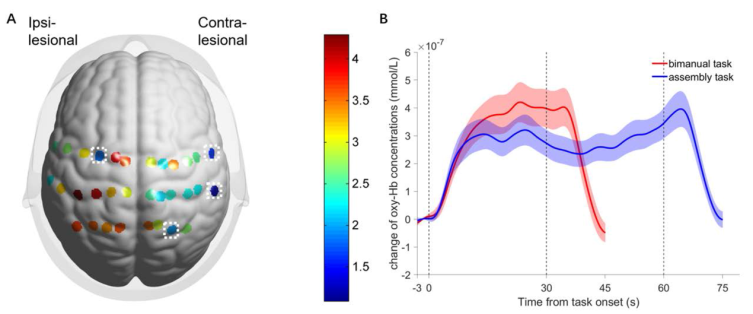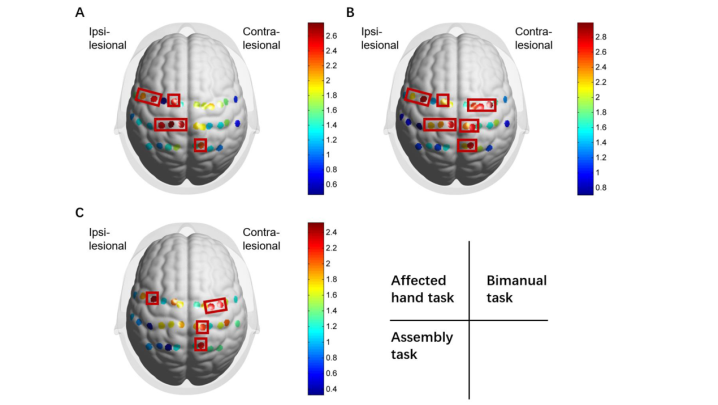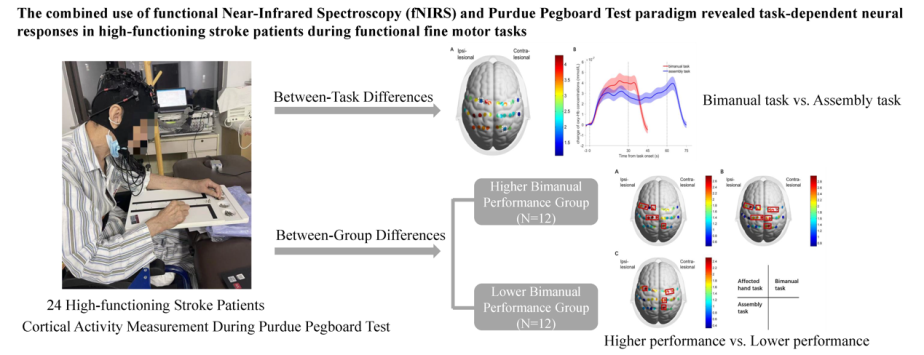NRR: 上海中医药大学许东升团队揭示高功能脑卒中患者完成不同形式双侧协调精细运动任务脑机制
脑卒中后,即使是功能较好的脑卒中患者在执行需要双侧协调和精细运动灵活性的手动任务时也面临挑战[1]。因此,恢复这些功能对于提高脑卒中患者的功能独立性至关重要。
双侧手臂训练(BAT)是一种针对双侧协调和精细运动技能的脑卒中康复策略,既往研究已显示出积极效果[2-3]。然而,BAT的潜在机制尚不清楚,而脑半球间传递抑制的耦合效应和恢复被认为可能是其益处的解释之一[4]。了解双侧协调与大脑活动之间的关系对于理解这些技能的神经生理基础并指导更有针对性的干预非常重要[5]。
尽管功能性神经影像技术在研究脑卒中后运动障碍的神经变化方面被广泛应用,但这些研究主要集中在涉及单个关节运动的简单实验室任务上,无法准确反映功能任务的复杂性。功能性近红外光谱(fNIRS)是一种新兴的非侵入性神经影像技术,具有对身体运动的最小限制并相对较强的抗运动伪迹能力[6]。然而,目前有关fNIRS在脑卒中患者功能性上肢运动方面的研究主要侧重于粗运动任务,对于手部灵巧性和不同双侧协调结构的活动,尤其是对于功能较好的脑卒中患者,尚未得到充分关注。
近日,上海中医药大学许东升团队在《中国神经再生研究(英文版)》(Neural Regeneration Research)上发表了题为“Cortical activity in high-functioning ischemic stroke patients during Purdue Pegboard Test: insights on bimanual coordinated fine motor skills with functional Near-Infrared Spectroscopy (fNIRS)”的研究论文。通过研究发现,在功能较好的脑卒中患者在进行不同精细运动时中存在任务特异性的神经反应模式差异。此外,空间和时间复杂性更高的双侧协调任务更具挑战性。值得注意的是,在双侧协调任务中表现较好的功能较好的脑卒中患者在运动相关区域表现出更高效的皮层激活,强调了有效的神经招募对于成功的运动表现的重要性。这些发现强调了在脑卒中后康复计划中引入双侧手臂训练和进行复杂的双侧协调任务对于功能较好的患者的重要性。总体而言,该研究为脑卒中患者双侧协调和精细运动技能的神经基础提供了有价值的见解,并展示了fNIRS与功能性运动范式相结合在评估和理解这些技能方面的实用性。陈思韵和毛梦钗为论文共同第一作者,许东升教授为论文通讯作者。
尽管脑卒中后,一些患者上肢功能恢复较好,但在执行需要双侧协调和精细运动灵活性的任务时也同样面临挑战[1]。因此,该研究首次利用利用功能近红外成像技术(fNIRS)观察了功能较好的脑卒中患者完成不同精细运动任务时的脑激活情况。此前,Kantank等将双手协调任务根据肢体运动的对称性和任务目标的概念化分为六个类别[7]。该研究使用的普渡钉板实验中的双手任务和组装任务可认为为具有独立目标的对称任务和具有独立目标或共同目标的非对称任务。作者研究结果显示,在完成对称性的双手协调精细任务,感觉运动区的激活程度较非对称的双手协调精细任务高。既往结果显示,通常脑卒中后非对称双侧协调动作的协调性受损程度比对称运动更大[5,8]。正如该研究中观察到的单手任务中皮层激活减少所示,脑卒中患者在空间和时间复杂性更高的功能任务中可能存在更多的神经缺陷。除此之外,该研究亦比较了双手协调性较好与较差的人群在完成不同精细动作任务时的皮层激活情况。结果显示,双手协调性较好的患者的感觉运动区的激活程度均低于较差的患者,且激活模式存在任务特异性。在健侧手任务时,主要在同侧脑半球观察到了差异。相比之下,在双手任务和组装任务中,分别在双侧感觉运动皮层和对侧脑半球起到了更突出的作用。因此,此结果或揭示双手协调性更好的脑卒中患者在执行单手和双手协调性任务时表现出更高的神经效率,且不同任务存在与任务相关的神经激活机制。

图1. 比较双手任务和组装任务之间的皮层激活和血流动力学变化 (图源:Chen S et al., Neural Regen Res, 2023)

图2. 比较高(N = 12)和低(N = 12)双手性能组在受影响的患手任务(A)、双手任务(B)和组装任务(C)中的皮层激活的通道级别比较 (图源:Chen S et al., Neural Regen Res, 2023)
总结来说,该研究具有新颖性,作者的研究为理解脑卒中患者精细运动控制和双手协调缺陷背后的神经机制做出了贡献。结果揭示了高功能性脑卒中患者在神经反应模式上的任务特定变化。此外,研究表明,具有较高时空复杂度的双手任务对高功能脑卒中患者提出了更大的挑战。值得注意的是,在双手协调任务上表现更好的高功能脑卒中患者展现了更高效的运动相关区域的皮层激活,这强调了有效神经招募对运动表现的重要性。这些发现凸显了在高功能患者的脑卒中康复计划中,引入双臂训练和复杂双手任务的重要性。该研究为理解脑卒中患者双手协调和精细运动技能的神经基础提供了脑机制证据,展示了功能性近红外光谱学(fNIRS)结合功能性运动范式评估和理解这些技能的实用性。
当然研究也存在一定局限性。首先该研究缺乏对照组,如果有对照组,将有助于确定脑卒中患者在任务中观察到的激活模式差异是由脑卒中引起的,还是健康个体中也存在的。该研究样本量小,可能无法代表更大的脑卒中患者群体。此外,也必须考虑可能的偏见或混淆源,如个体之间运动能力或注意力差异,这些可能影响了结果。未来的研究应该通过实施更严格的纳入标准和控制可能的混淆变量来解决这些问题。研究的横断面设计也使得难以确定任何训练相关的改善。此外,该研究仅关注了大脑的运动相关区域,没有考虑到功能性精细运动任务的认知方面,例如前额叶皮层。
文中,作者亦为未来的研究指引了方向。例如,通过研究特定任务来揭示脑卒中患者协调缺陷背后的神经机制,采用纵向设计来探究双侧运动神经激活模式和功能结果的时间变化,比较不同类型的双侧运动干预,考虑到个体差异,包括诸如病灶位置、严重性、认知能力和基线运动功能等因素等。通过解决这些研究领域,未来的研究工作可以提高对脑卒中患者协调缺陷的知识,为康复实践提供基于证据的信息,并最终优化功能结果。
原文链接:https://doi.org/10.4103/1673-5374.385312
参考文献:
[1] Patel P, Kaingade SR, Wilcox A, et al. Force control predicts fine motor dexterity in high-functioning stroke survivors. Neurosci Lett. 2020;729:135015.
[2] Chen PM, Kwong PWH, Lai CKY, et al. Comparison of bilateral and unilateral upper limb training in people with stroke: A systematic review and meta-analysis. PLoS One. 2019;14:e0216357.
[3] Chen S, Qiu Y, Bassile CC, et al. Effectiveness and success factors of bilateral arm training after stroke: a systematic review and meta-analysis. Front Aging Neurosci. 2022;14:875794
[4] Wu JY, Cheng H, Zhang JQ, et al The modulatory effects of bilateral arm training (BAT) on the brain in stroke patients: a systematic review. Neurol Sci. 2021;42:501-511.
[5] Kantak S, Jax S, Wittenberg G. Bimanual coordination: A missing piece of arm rehabilitation after stroke. Restor Neurol Neurosci. 2017;35:347-364.
[6] Perpetuini D, Cardone D, Filippini C, et al. A motion artifact correction procedure for fNIRS signals based on wavelet transform and infrared thermography video tracking. Sensors (Basel). 2021;21:5117
[7] Kantak SS, Zahedi N, McGrath RL. Task-dependent bimanual coordination after stroke: relationship with sensorimotor impairments. Arch Phys Med Rehabil. 2016;97:798-806
[8] Cauraugh JH, Summers JJ. Neural plasticity and bilateral movements: A rehabilitation approach for chronic stroke. Prog Neurobiol. 2005;75:309-320
图示摘要:


陈思韵,毕业于美国哥伦比亚大学医学中心,取得物理治疗学博士学位(DPT)。目前为上海中医药大学康复医学院在站博士后,导师许东升教授。研究方向为神经系统疾病后的运动再学习与运动控制,协调性的康复干预。发表学术论文10篇,其中SCI论文5篇。获选国家博士后国际引进人才项目。

毛梦钗,生物学、心理学和认知神经科学专业背景。就职于上海中医药大学康复医学院/教育部康复工程研究中心,从事脑功能成像研究以及脑功能障碍康复工作。发表学术论文10篇,其中SCI收录论文8篇,中文核心期刊论文2篇;申请专利3项;获上海康复医学科技奖。




